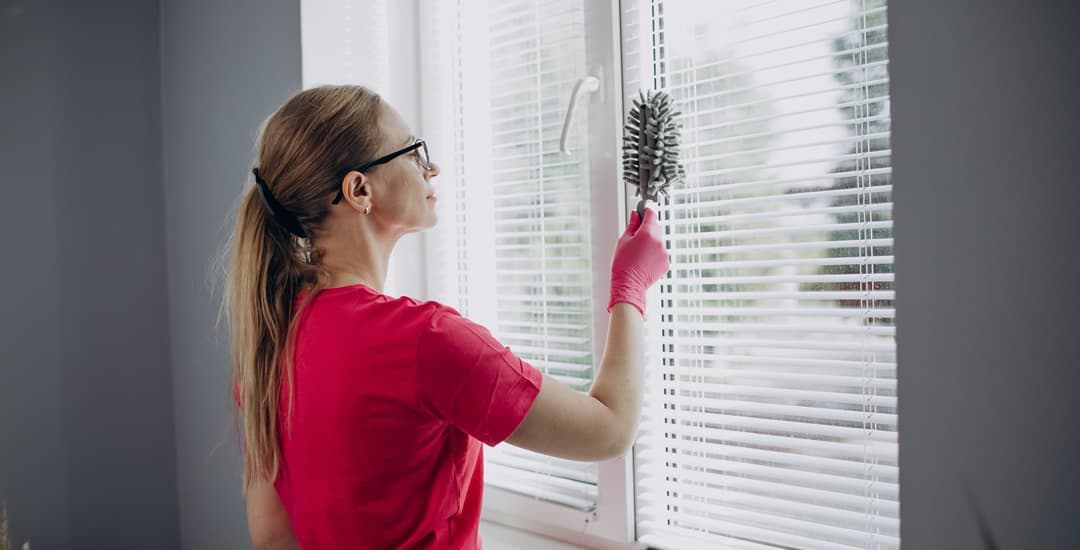
Happy chocolate and hot cross buns month, blinds enthusiasts! Also, happy “is he or isn’t he going to vomit from running around the garden while eating chocolate” month, for the parents among you.
Anyhoo, April doesn’t just mean Easter, but also for many of us, time to consider spring cleaning; or for me, “cleaning properly for the only time that year,” after which visitors will have a narrow two-week window to accept an invite into my home before it’s all over until next spring.
If you are spring cleaning or planning to have a bit of a turf out and clear out this month, it’s a good idea to get your window blinds in on the action too, which, a bit like the ice cube trays in your freezer, are one of the most commonly overlooked things when it comes to being cleaned as often as they should be.
Sooo, how do you spring clean blinds? This very much depends on the type of blinds you’ve got, as well as how clarty they are, and whether your idea of clean means “clean on the bits people can see,” or uh, actually really properly clean.
In this blog post I’m going to provide some really quick, shortform, universal directions and tips on how to clean blinds of all types; and I also urge you to read my companion post on how not to clean window blinds too if you’re a bit of a cleaning maverick.
What are the most low-maintenance blinds when it comes to cleaning?
If your main criteria for buying things is not having to clean them too much (fair, my main criteria for buying dresses is not having to iron them) then window blind types ranked from easiest/fastest to hardest/most time consuming to clean are:
- Roller blinds
- Vertical blinds
- Day and night blinds
- Pleated blinds
- Faux wood blinds
- Aluminium Venetian blinds
- Wooden blinds
- Roman blinds
If you want to know exactly why that is, you can find out more here.
What is the easiest way to clean blinds?
For basic cleaning on blinds of all types (and this is all that many or most blinds will ever need, with the potential exception of blinds used in wet or humid environments like the bathroom and kitchen, with this latter also potentially involving contact with food and grease too) all you need to do is dust your blind off with a feather duster or soft cloth, and ideally, continue to do so once a week or so.
I also advise opening and closing your blinds at least once a week (if you don’t use them regularly anyway) as this will help to stop dust from settling, and also help to keep the working mechanisms in good and functional order.
How to spring clean blinds used in humid rooms or grubbier environments
Blinds in kitchens and bathrooms and other rooms where the blinds might come into contact with humidity, liquids, or muck are (or certainly should be if you made good purchasing decisions in the first place) waterproof blinds.
While these can come in many different formats and be made in a wide range of materials ranging from PVC to faux-wood, they can all be wiped off with a wet cloth and a bit of washing up liquid or other form of gentle detergent.
It doesn’t matter how wet you get them, and you can use various different detergents too as long as they’re not too aggressive. Always rinse any cleaning products off thoroughly when they’re clean, and extend or fully open the blind to allow it to dry completely before the next time you close it.
Are there any blinds cleaning hacks I should know about?
Why yes, I’m glad you asked that. Dear old Mrs. Hinch is known for coming up with some fairly off-the-wall cleaning suggestions, some of which are genius while others are somewhat questionable, this latter being from our viewpoint as a blinds maker and retailer best avoided.
She’s shared two tips to date when it comes to Hinching window blinds, and one of them falls into the “genius” category, and the other into the “nope” section…
Using a tumble dryer sheet to clean/wipe off the slats of Venetian, real wood, and faux-wood blinds is the Mrs Hinch window blind cleaning hack that I’m fully on board with. This not only removes dust and makes things smell nice, but it also helps to repel future dust from settling thanks to its antistatic effect.
On the other side of the coin, Mrs. Hinch’s tip to clean window blinds with Zoflora is one that I/we as the parents of many healthy, well-balanced sets of blinds, advise against.
If you know of any other quick, effective, and safe ways to clean blinds that I have not covered, or think you might have an idea but are lairy of trying it out just in case, tell me in the comments.




